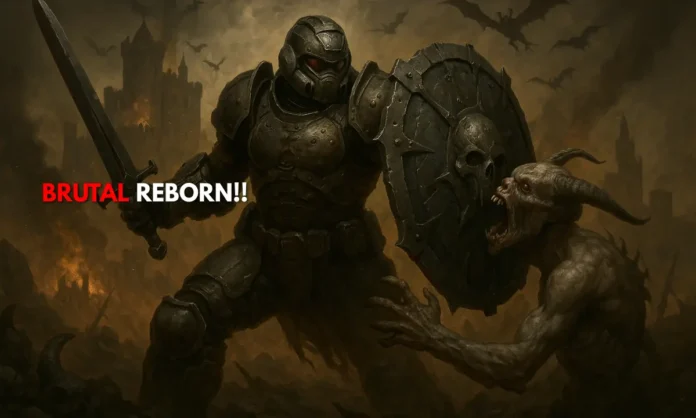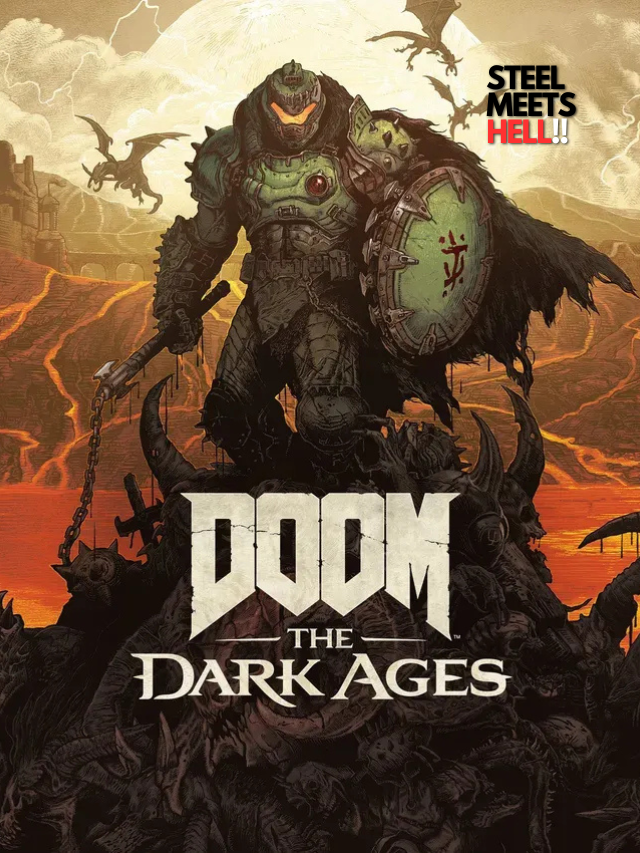SUMMARY
- The Dark Ages trades the lightning pace of Doom Eternal for raw, medieval muscle
- New combat mechanics center on shields, projectile parries, and stunning glory kills
- While technically bold, the game’s vast levels occasionally stretch gameplay thin
A Medieval Detour That Hits Harder Than Expected
In Doom: The Dark Ages, the franchise that redefined first-person shooters takes an unexpected detour through time—and tone. As a prequel to id Software’s 2016 Doom reboot and its hyperkinetic sequel Eternal, this latest entry sheds speed for scale, favoring grounded brutality over evasive finesse. The result is a refreshingly raw brawler disguised as a shooter. Gone are the arena-style leaps and frenetic weapon swaps. Here, the Doom Slayer trudges like a one-man siege engine, wielding his shield not just for defense but for dominance.
This shift reflects a philosophical reboot as much as a mechanical one. If Eternal was about juggling movement, ammo, and enemies with gymnast-like precision, The Dark Ages asks you to stand firm, learn patterns, and crush. Its approach to violence is less surgical, more sledgehammer. And that is both its draw and its dilemma. Where it innovates in tone and concept, it also introduces new challenges—some rewarding, others cumbersome. At its best, The Dark Ages is a slow-motion power fantasy that rewires your expectations of what a Doom game can feel like. At its worst, it’s a weighty stroll through stunning—but sometimes underused—scenery.
#DOOMTheDarkAges: 10 Things You NEED TO KNOW!
— Artane (@Art_inPlay) May 12, 2025
1️⃣ DOOM: The Dark Ages rethinks movement.
Forget the jet-speed of DOOM Eternal—this time, you're a tank. Slower, heavier, and more grounded. Less platforming, more holding your ground and fighting head-on. pic.twitter.com/RdRph5cZMX
Doom Reimagined: From Fast-Fire to Blunt Force Trauma
- Combat is slower, denser, and grounded in projectile counters and shield mechanics
- Executions remain brutal, though now less elaborate and more utilitarian
- Melee-focused enemies introduce duel-like pacing rarely seen in the series
The heart of The Dark Ages is combat with consequence. Rather than darting through killzones, the Doom Slayer now absorbs the rhythm of battle. With a thudding step and a shield that can deflect—and sometimes reflect—enemy attacks, every encounter feels like a deliberate exchange rather than a chaotic explosion. Projectiles now drift, not dart. Blocking a fireball and stunning the enemy leads to a visceral glory kill, often a single punch or kick. It’s stripped-down carnage, and it works.
Demons behave more like arena bosses—many are melee fighters, encouraging you to engage on their terms. Larger arenas swarm with lesser enemies acting as shields and distractions. It’s less ballet, more brawl. To compensate for the pace, id Software introduces toys: a rail-spike launcher, shrapnel blasters, and clever finishers. But the theme is constant—stay put, hit hard, and make your hits count.
Size Isn’t Everything: When Level Design Slows the Game Down
- The game spans 22 massive levels—many are open-ended with multiple paths
- Traversal often feels like filler between fights, not a vehicle for tension
- Exploration is occasionally enriched by mech and dragon sequences, but they lack depth
The Dark Ages wants to impress, and visually, it often does. But grandeur comes at a price. Many levels feel padded—designed for breadth, not depth. While multiple pathways encourage exploration, the core combat experience sometimes loses urgency amid the wandering. You’ll stumble upon secrets and challenges, but not always the satisfying kind.
To keep things fresh, id throws in mech battles (via the lumbering Atlan) and dragon flights. The former lets you box mountains. The latter lets you soar. Both sound cooler than they play. These segments echo early-2000s shooter gimmicks—visually rich but mechanically shallow. They don’t ruin the game, but they don’t elevate it either.
Glory with Grit: A Shooter That Dares to Slow Down
- id Software’s experimentation shows clear ambition—even if pacing stumbles
- The combat shift marks a tonal high point, less frantic and more primal
- This isn’t Eternal, and that’s both a relief and a risk
Doom: The Dark Ages may not reach the adrenaline highs of its immediate predecessors, but that doesn’t make it lesser—just different. It trades fluidity for finality, replacing the dance with a duel. This game doesn’t want to make you feel fast. It wants to make you feel inevitable.
And yet, for all its ambition, it occasionally forgets how to balance power with momentum. Long levels and gimmick-laden interludes test your patience. But when the combat lands—as it often does—it’s glorious. The Dark Ages may not redefine shooters like Doom 2016 did, but it reminds us that even icons benefit from reinvention.
A Brutal Rebirth, Not a Revolution
Doom: The Dark Ages is a confident, creative detour that dares to shift gears in a franchise built on velocity. By grounding its combat in weight, rhythm, and medieval force, id Software reimagines what the Doom Slayer can be—not a blur of movement, but an unstoppable presence. The game’s core mechanics—especially its shield-based counters and redesigned enemy choreography—are satisfying, impactful, and distinctly its own.
Yet ambition is a double-edged axe. The game’s sprawling levels, uneven pacing, and occasional overindulgence in scale dilute some of that newfound intensity. At times, The Dark Ages seems trapped between a desire to be cinematic and a need to stay taut. Not every experiment lands, and the ride occasionally slows to a crawl.
Still, in a genre that too often rehashes old formulas, Doom: The Dark Ages earns credit for trying something bold. It’s not the most refined entry in the series, but it is among the most interesting—and when its hammer hits, it hits hard.



